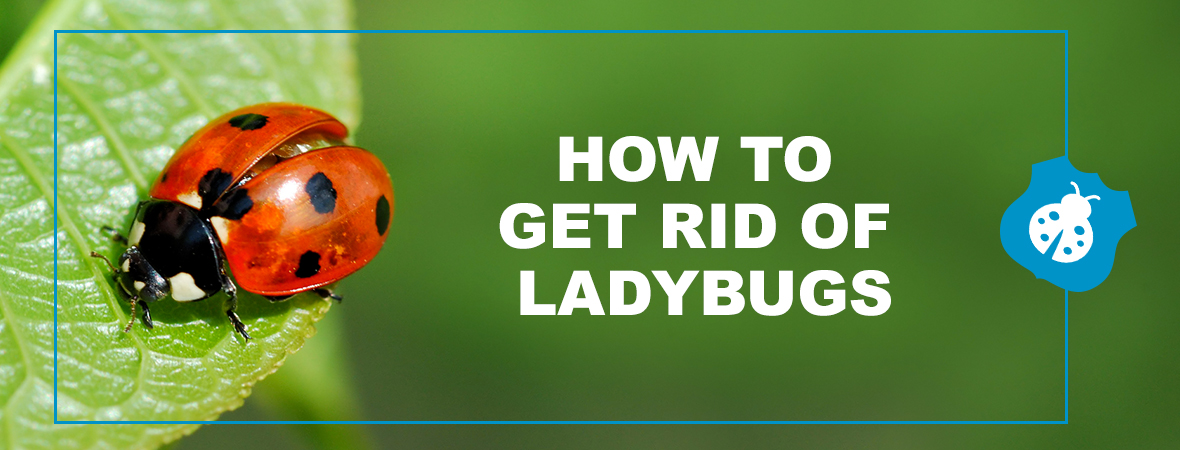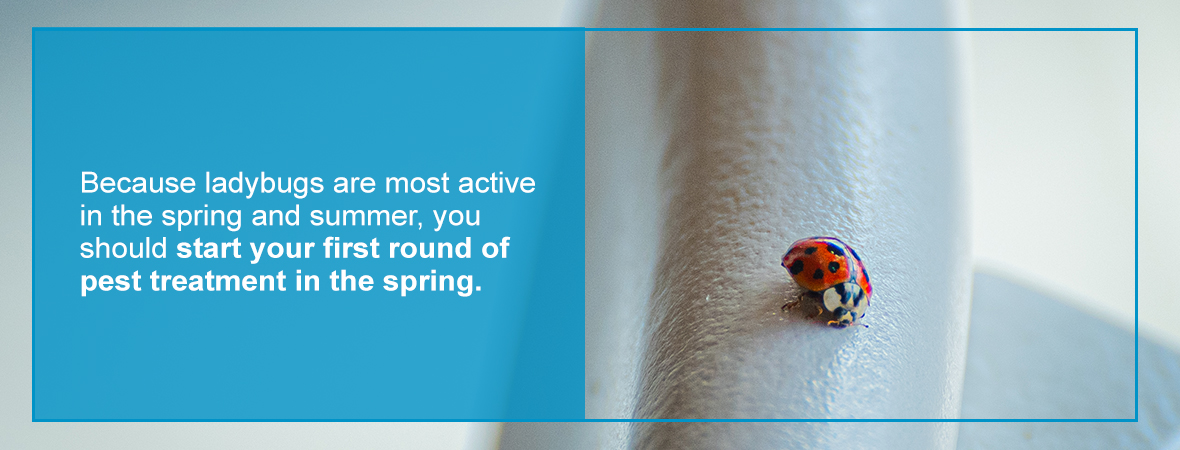How to Get Rid of Ladybugs

While some insects are pretty to observe, they’re far more fun to look at when they’re not inside your house — and ladybugs, or lady beetles, are no exception. These small, short-legged insects have antennae and round or oval-shaped domes. Their distinctive red coloration and black spots make them easy to spot against grass or plants, and they’re commonly considered a sign of good fortune.
However, ladybugs in the house are not so lucky. As ladybugs tend to hibernate in human-occupied structures, they can become nuisances in the fall and winter. If you’ve noticed an influx of ladybugs in your house, you’ll want a reliable way to remove them.
Are Ladybugs Dangerous?
Do you have anything to worry about if you see ladybugs in your home? While ladybugs may not be as immediate a threat as other pests, they can still pose substantial problems to your home. Here are a few ways ladybugs can potentially harm you and your home.
Do Ladybugs Bite?
Yes, ladybugs may bite if they feel provoked. However, they can’t break human skin, so you’ll only feel a slight pinch. When a ladybug lands or crawls across your skin, they may scrape it with their sharp mouthparts. While ladybug bites aren’t overtly dangerous to people and won’t expose you to any diseases or parasites, some individuals may be minorly allergic to ladybug bites.
These allergic reactions may take the form of a raised red bump or welt, a rash, sneezing or itchy eyes. These insects may also aggravate asthma in some people, which provides another compelling reason for ladybug pest control.
Are Ladybugs Poisonous?
Yes, ladybugs are poisonous and contain a mild toxin, which is only dangerous if ingested. Their contrasting bright red coloring is a form of aposematic coloration intended to signal to predators they’re poisonous. If a ladybug feels threatened, it can secrete a viscous yellow, foul-smelling and unappetizing fluid from the joints in its legs as a defense mechanism. This defense secretion may stain whatever it comes into contact with and may also trigger an allergic reaction.
Will Ladybugs Damage Your Home?
Once ladybugs set up shop within your home, it can be challenging to get them to leave. These bugs can lay up to 1,000 eggs in their lifetime, resulting in an exponential expansion in a short amount of time. Fortunately, ladybugs don’t pose any threat to the wood or fabric in your homes, but some ladybug species can damage house plants.
Why Are There So Many Ladybugs Inside?
During the fall and winter, adult ladybugs may try to enter your home in search of a safe and warm place to hibernate. They’ll cluster around buildings in large numbers in search of protected sites for the winter and sneak into your home through common entry points such as cracks or holes in your siding, doors and windows. Once they enter the walls, they may proceed to the interior of the building. Most likely, you’ll see ladybugs in the attic, on window sills and on house plants.

Typically, ladybugs are more attracted to buildings that receive afternoon sun exposure on the south and southwest sides. They’re also attracted to lighter-colored houses. When they find a good site, ladybugs will release a powerful attractant pheromone to signal to others they’ve found a good spot to spend the winter. As a result, hundreds of ladybugs may try to enter your home and return every year.
How to Prevent Ladybugs From Entering Your Home
If you want to keep ladybugs out of your home, there are several effective preventative measures you can take to address any interior or exterior vulnerabilities in your home. The best methods for preventing ladybugs from entering your home are to:
- Ensure you’ve sealed all your doors and windows adequately: Materials like weather stripping, caulking, door sweeps and thresholds can help winterize your home and protect it against unwanted pests. Remember to replace any damaged window screens, as well. As ladybugs can squeeze through tiny openings, it may be helpful to use high-quality silicone or acrylic latex caulk around windows. Therefore, your house will have proper insulation against the cold, and ladybugs won’t be able to infiltrate your home.
- Patch potential entry points: One of the best ways to keep ladybugs out of your home is to make sure you close any gaps you see around wires, utility pipes, cables and meters and behind chimneys. Try expandable foams, caulk, copper mesh or steel wool to seal these entry points on the outside of your home.
- Use natural repellants: Flowers such as mums or lavender will repel ladybugs in your yard and around entryways — and you can even transplant these plants into pots to keep inside. The presence of these plants will help discourage ladybugs from entering your home. Other natural ladybugs repellants include bay leaves, citrus and cloves.
- Begin your first round of treatment during the spring: Because ladybugs are most active in the spring and summer due to the abundance of tender foliage and the population boom of aphids, you should start your first round of pest treatment in the spring. As a result, you’ll stop the influx of ladybugs before they seek protection for the winter. Once ladybugs become established within your home, your treatment options will be far more limited.
How to Get Rid of Ladybugs
What should you do if you have an existing ladybug infestation? Try these steps.
1. Sweep or Vacuum
The most effective way to remove ladybugs is to sweep them with a broom or use a vacuum cleaner to collect them gently. Remember that if ladybugs do get into your home, they’ll release their smelly yellow fluids if you squash them!
The best way to avoid odor and stains is to gently collect them and dump them into a sealed bag. Then, empty them outside to remove them from their colony and discourage other ladybugs from entering your home.
2. Use Dish Soap
Try spraying ladybugs with soapy water or placing a bowl containing dish soap and water near an area where they gather. If you have a cluster of ladybugs gathering outside your home, you can also scrub the area with soapy water. The smell of the soap will remove the scent of the ladybugs’ pheromones and prevent more from getting into your home.
3. Try Duct Tape
Use duct tape to remove hard-to-reach ladybugs from the corners of your home. By wrapping the duct tape around your hand or finger, you eliminate any contact with the ladybugs, and you can safely remove the colony to release them outside. Try placing duct tape as a kind of sticky trap to capture any stray ladybugs crawling around your home.
4. Place a Light Trap
Use a ladybug-friendly light trap to attract ladybugs that have infested a dark area, such as your attic or in the walls. To make your own, you can use everyday kitchen items such as a plastic jug or empty soda bottle and an LED bulb. The ladybugs will flock to the light and become stuck in the bottom of the container. After you’ve trapped the ladybugs, you can return them to their proper place outside.
5. Contact a Professional Pest Control Service
For a heavy infestation, it’s best to seek professional pest control advice. Pestech can help assess the problem, get rid of the ladybug infestation and prevent them from reentering your home.
Choose Pestech for Pest Proofing and Exclusion
While ladybugs can be helpful garden companions, it’s best to keep them out of your home. If you have a ladybug infestation, you can trust Pestech’s pest proofing and exclusion services. We ensure a response within 24 hours for all of your pest concerns and offer dependable preventative measures to deter ladybugs for years to come. As the largest family-owned pest management center in New York, we offer locations throughout Hudson Valley, NY to suit your family’s needs.
Our expert pest management technicians ensure the highest quality solutions for even the most difficult infestations with a 100% satisfaction guarantee. Contact us to learn more about our pest management services or to schedule your inspection.

